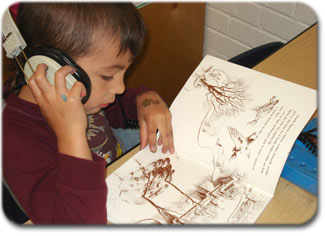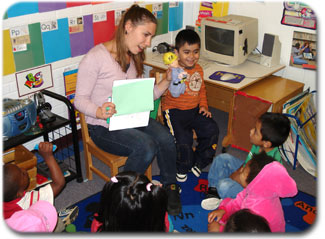2.8 Structure activities so children are actively engaged almost all of the time (i.e. actively participating). Change my activity when children lose interest.
 Example: the teacher has provided the child with an alternative way to participate in the activity of shared book reading. He can use the head phones to listen and "read-along" to the story.
Example: the teacher has provided the child with an alternative way to participate in the activity of shared book reading. He can use the head phones to listen and "read-along" to the story.- Arrange activities to promote active engagement with materials, independence and social interaction.
Read: How to ensure the active engagement of all children
Read: How to Engage Children who are Difficult to Engage
- When children begin to show challenging behavior (or better yet, when they first become disengaged BEFORE any challenging behavior), help them become actively engaged in the activity or provide a new activity.
Watch: "Outdoor play"
 Keep in mind that "actively engaged" may look different for each child. One child may be actively engaged in a shared story book reading by sitting quietly and looking at the book. Another child may be actively engaged in shared book reading by standing and holding a story prop.
Keep in mind that "actively engaged" may look different for each child. One child may be actively engaged in a shared story book reading by sitting quietly and looking at the book. Another child may be actively engaged in shared book reading by standing and holding a story prop.


 Example: the teacher has provided the child with an alternative way to participate in the activity of shared book reading. He can use the head phones to listen and "read-along" to the story.
Example: the teacher has provided the child with an alternative way to participate in the activity of shared book reading. He can use the head phones to listen and "read-along" to the story. Keep in mind that "actively engaged" may look different for each child. One child may be actively engaged in a shared story book reading by sitting quietly and looking at the book. Another child may be actively engaged in shared book reading by standing and holding a story prop.
Keep in mind that "actively engaged" may look different for each child. One child may be actively engaged in a shared story book reading by sitting quietly and looking at the book. Another child may be actively engaged in shared book reading by standing and holding a story prop.